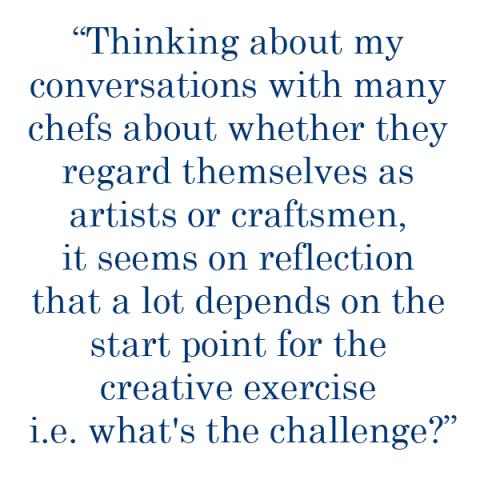This is the next installment in a series of blogs from performance psychologist Mike Duckett of Coaching for Success, helping chefs to raise their games in the kitchen.
 If you haven’t been following this series of blogs on the GROW model, just to give you the nutshell catch-up, it's a way of structuring a conversation with someone with the intention of helping them improve their performance and ‘grow’. It also helps you stay away from taking over and being the one who solves problems because then everyone will bring more and more problems to you. As my old corporate boss said, “never bring me a problem without your solution to go with it”!
If you haven’t been following this series of blogs on the GROW model, just to give you the nutshell catch-up, it's a way of structuring a conversation with someone with the intention of helping them improve their performance and ‘grow’. It also helps you stay away from taking over and being the one who solves problems because then everyone will bring more and more problems to you. As my old corporate boss said, “never bring me a problem without your solution to go with it”!
GROW stands for:
Goal (how you’d like things to be)
Reality (how they are at the moment)
Options (in how many ways could you fill this gap)
Now we come to the final part of the conversation; W – who will do what, when? What’s the action required to make a change here?
This may seem like the most obvious step in the process and as such hardly needs stating. However, it is as important as all the other steps because if nothing happens as a result of this conversation, it's just been a nice conversation. Sometimes as you talk this through everything goes swimmingly, with sage head nodding etc. until you ask for commitment to action by a specific person; then you get sounds like someone is being strangled or lots of huffing and puffing along with no eye contact. This is a sure sign this person really wanted you to lift the burden and take on their monkey to feed.
 If you don't agree an action list and just stop at Options, you're likely to end up with the idea something will change but be frustrated when the same old issue crops up later because no one made the change happen. How many times have you concluded a conversation that had the ideal next step everyone agreed was brilliant, only to look back a few months later and say, “I thought we'd agreed xyz, so why has no one done anything?”
If you don't agree an action list and just stop at Options, you're likely to end up with the idea something will change but be frustrated when the same old issue crops up later because no one made the change happen. How many times have you concluded a conversation that had the ideal next step everyone agreed was brilliant, only to look back a few months later and say, “I thought we'd agreed xyz, so why has no one done anything?”
Truth is there’s usually a list of more than one action required and some of them may be yours. For example, when I'm coaching someone and we discuss, say leadership ideas, I may recommend


 If you haven’t been following this series of blogs on the GROW model, just to give you the nutshell catch-up, it's a way of structuring a conversation with someone with the intention of helping them improve their performance and ‘grow’. It also helps you stay away from taking over and being the one who solves problems because then everyone will bring more and more problems to you. As my old corporate boss said, “never bring me a problem without your solution to go with it”!
If you haven’t been following this series of blogs on the GROW model, just to give you the nutshell catch-up, it's a way of structuring a conversation with someone with the intention of helping them improve their performance and ‘grow’. It also helps you stay away from taking over and being the one who solves problems because then everyone will bring more and more problems to you. As my old corporate boss said, “never bring me a problem without your solution to go with it”! If you don't agree an action list and just stop at Options, you're likely to end up with the idea something will change but be frustrated when the same old issue crops up later because no one made the change happen. How many times have you concluded a conversation that had the ideal next step everyone agreed was brilliant, only to look back a few months later and say, “I thought we'd agreed xyz, so why has no one done anything?”
If you don't agree an action list and just stop at Options, you're likely to end up with the idea something will change but be frustrated when the same old issue crops up later because no one made the change happen. How many times have you concluded a conversation that had the ideal next step everyone agreed was brilliant, only to look back a few months later and say, “I thought we'd agreed xyz, so why has no one done anything?”
 Mike Duckett has a degree in psychology and is a member of the Occupational Psychology division, the Sports Psychology division & the Coaching Psychology Special Group of the British Psychological Society. He holds a diploma in Hypnotherapy & Cognitive therapy and is a certified NLP coach.
Mike Duckett has a degree in psychology and is a member of the Occupational Psychology division, the Sports Psychology division & the Coaching Psychology Special Group of the British Psychological Society. He holds a diploma in Hypnotherapy & Cognitive therapy and is a certified NLP coach.









